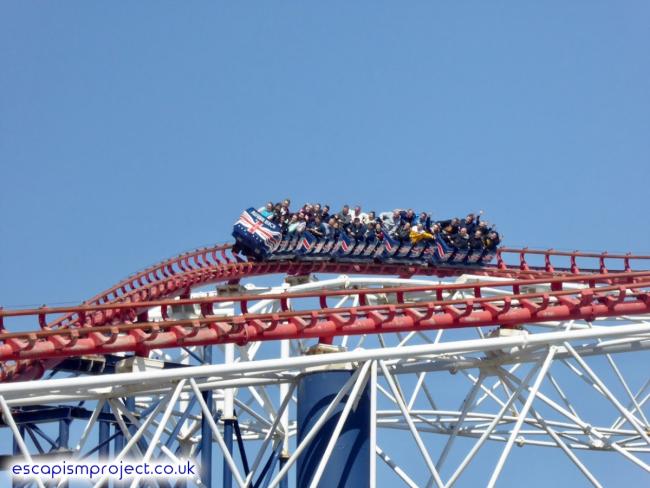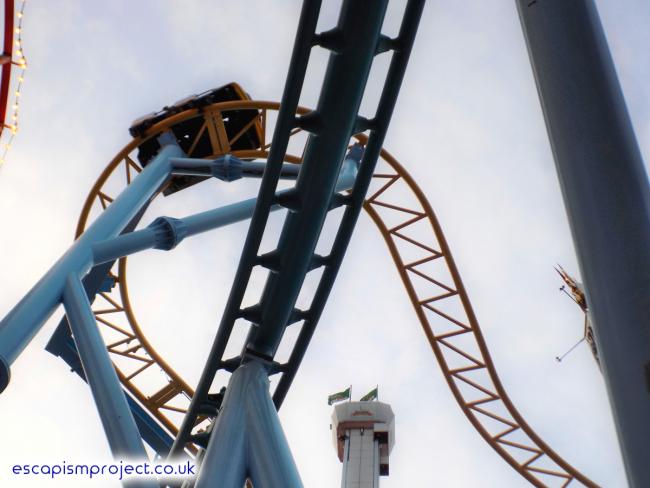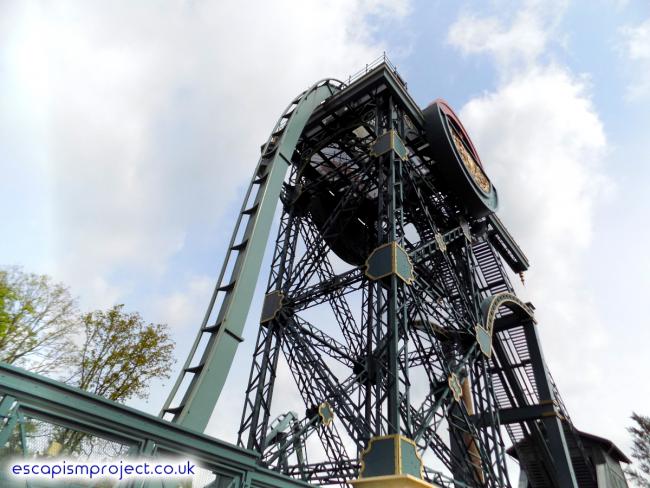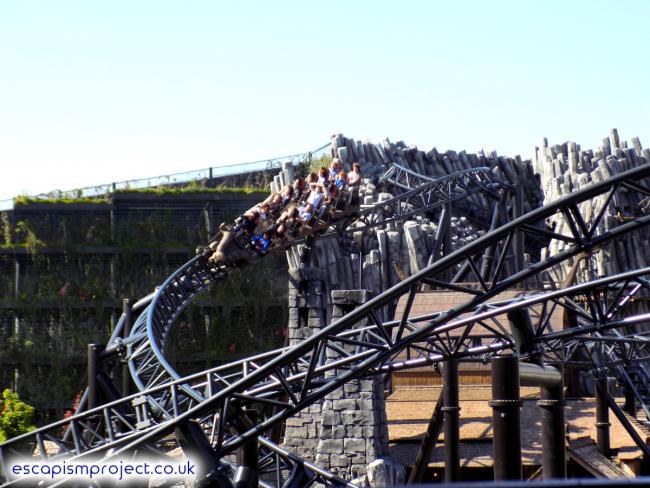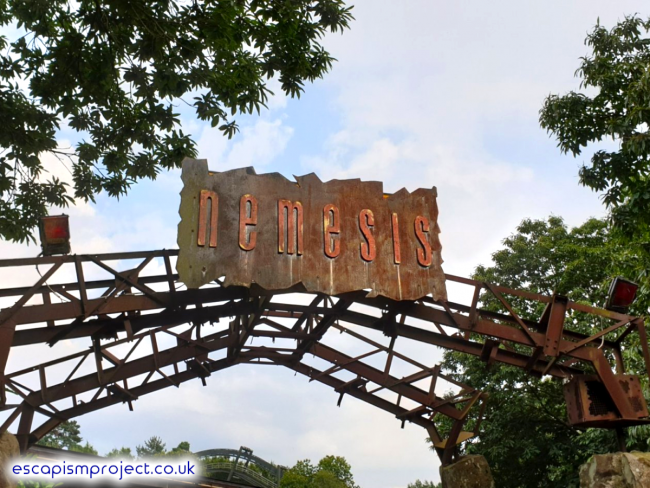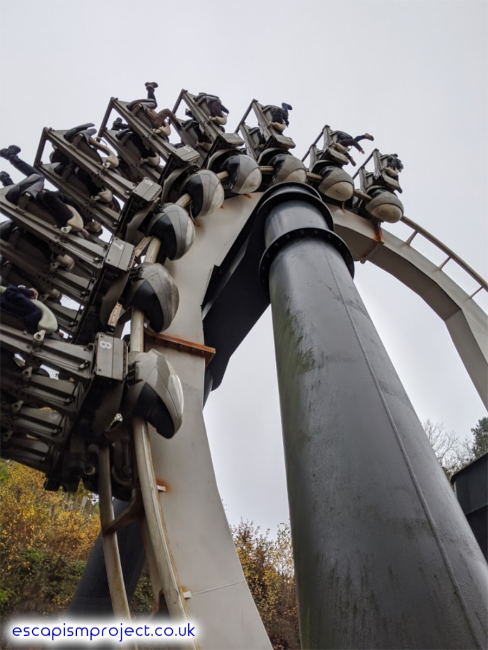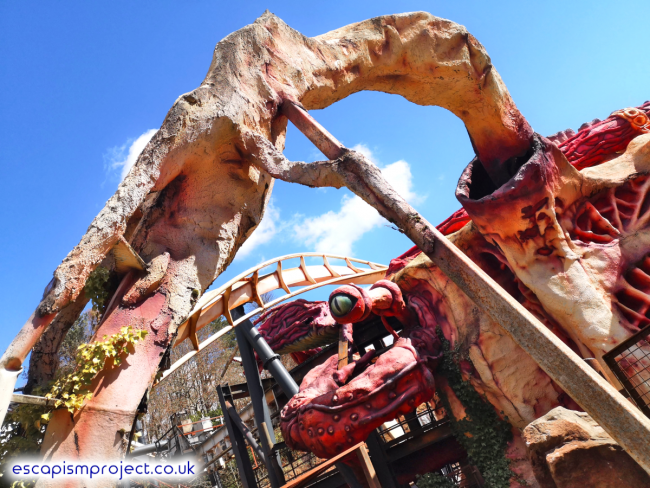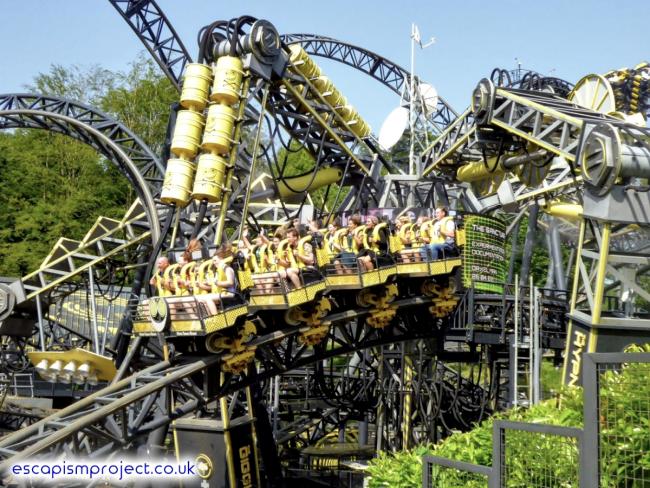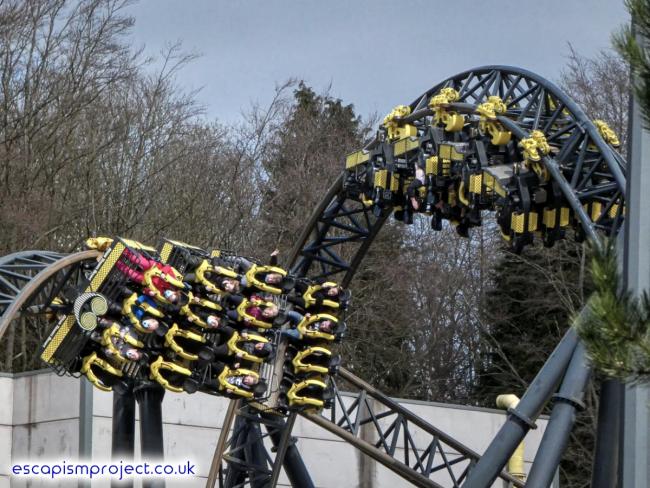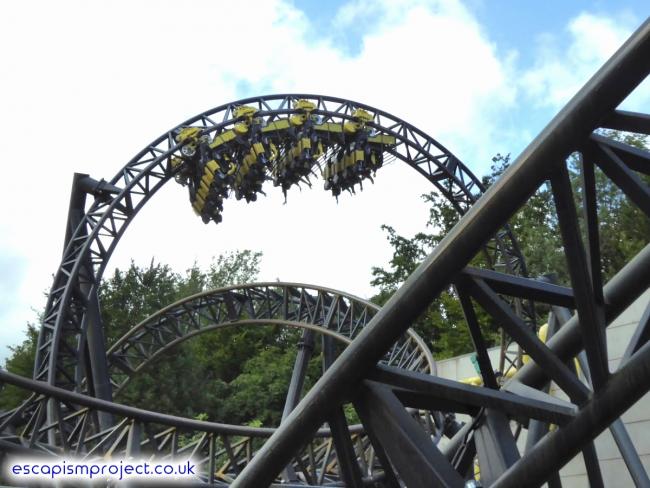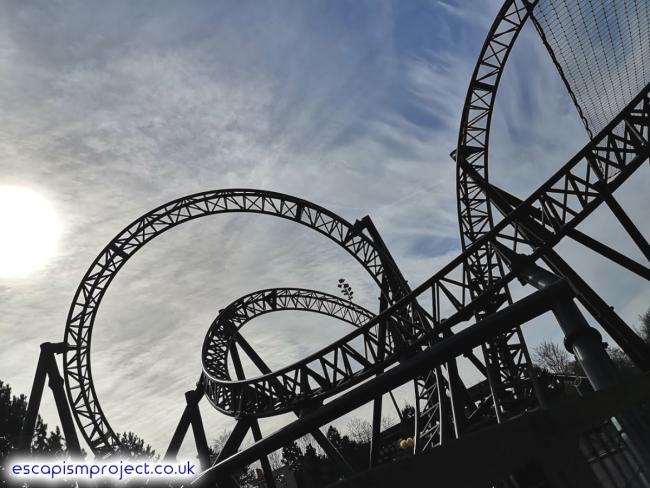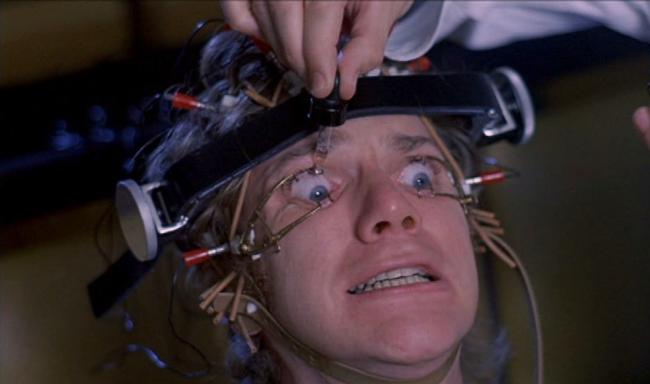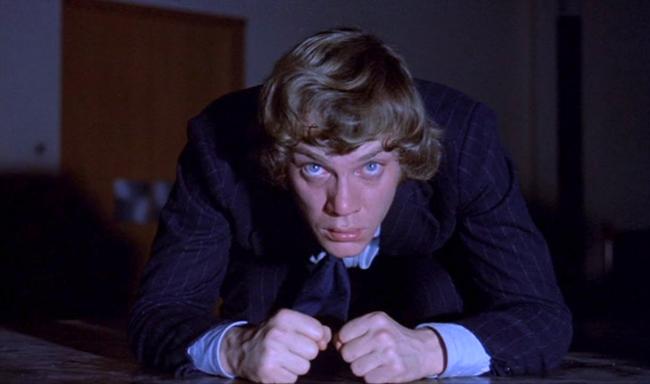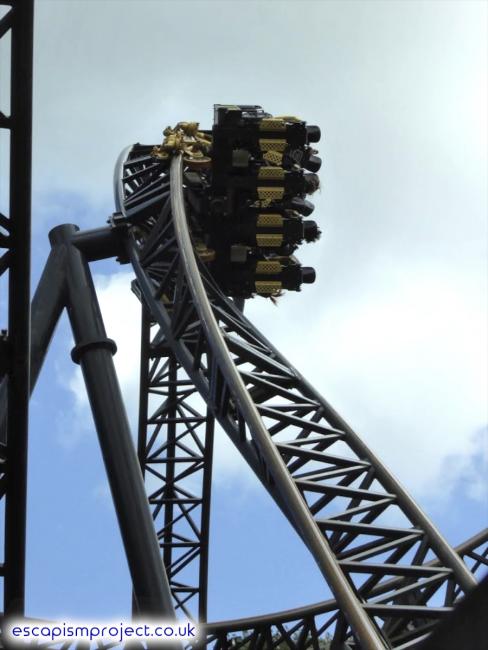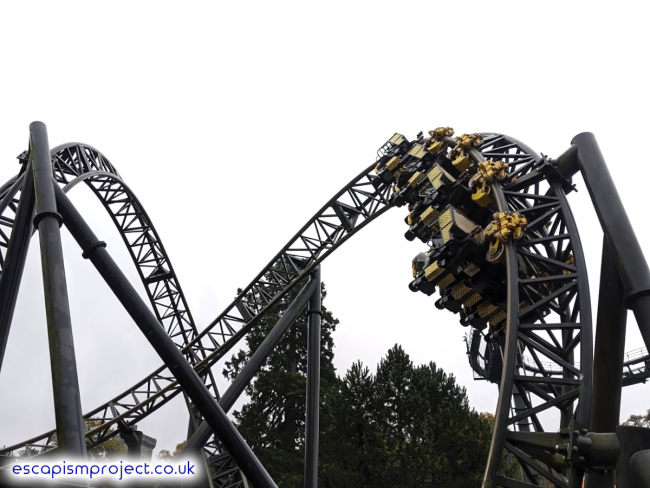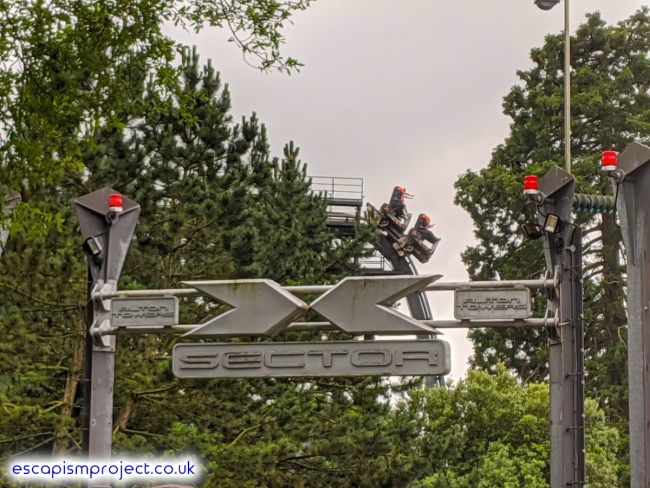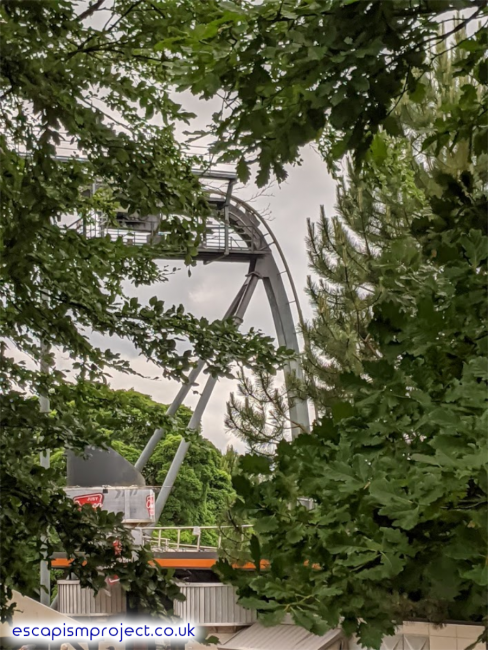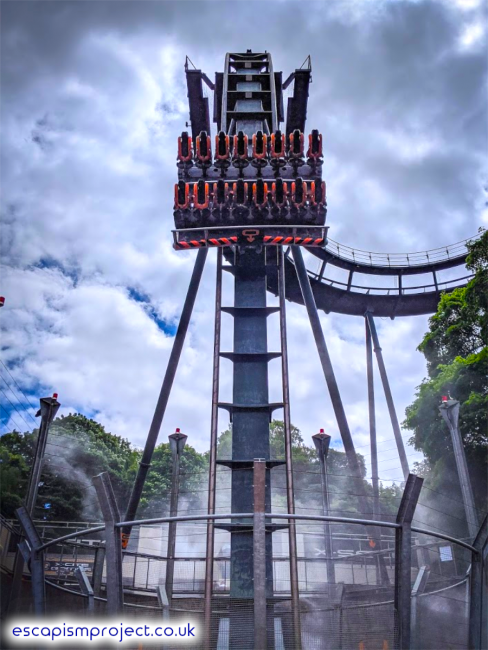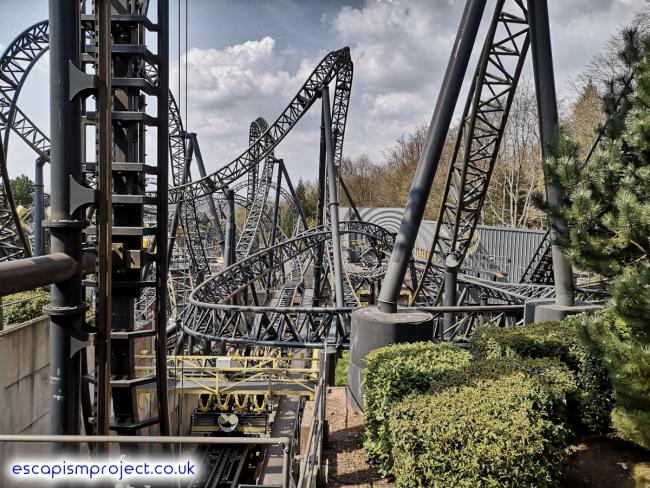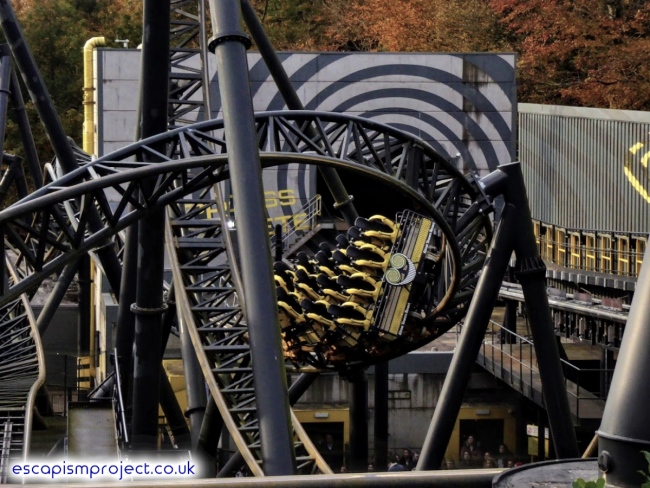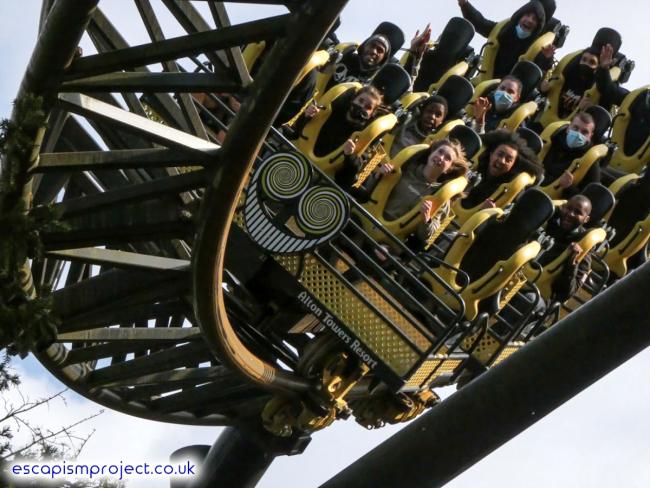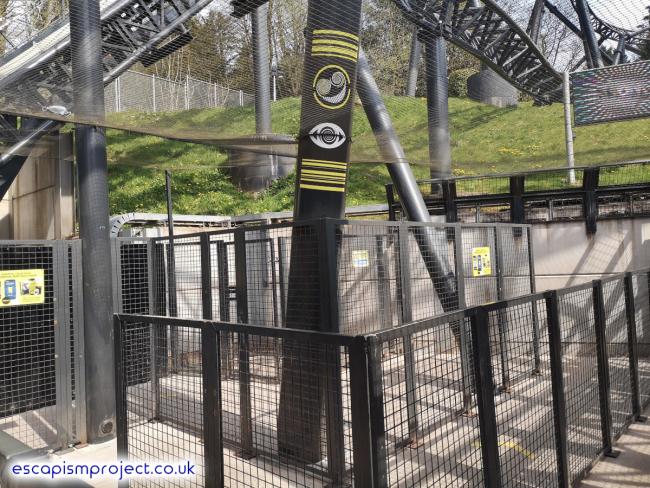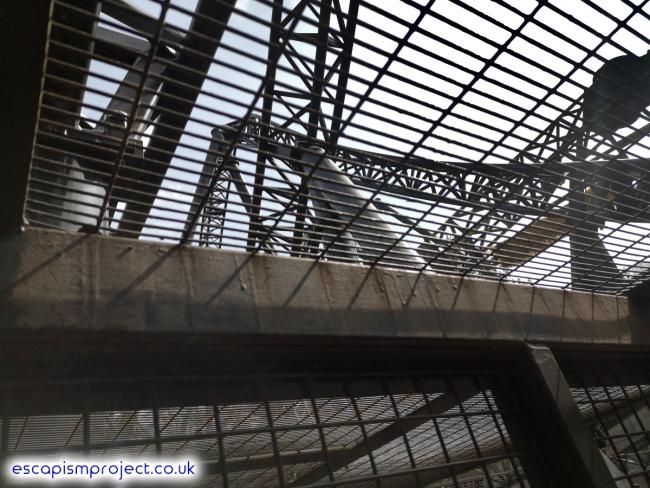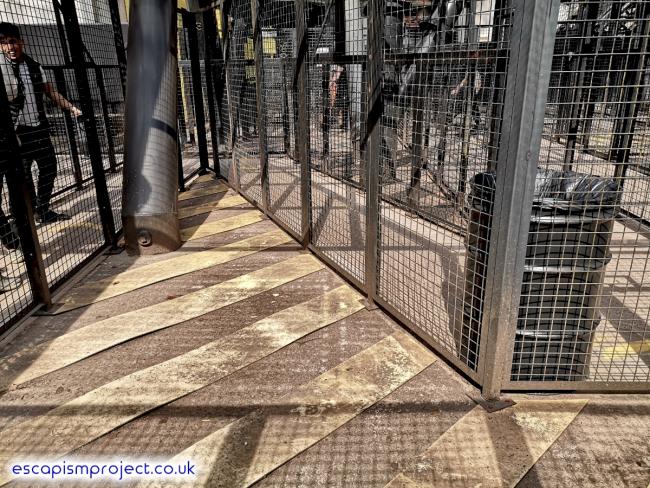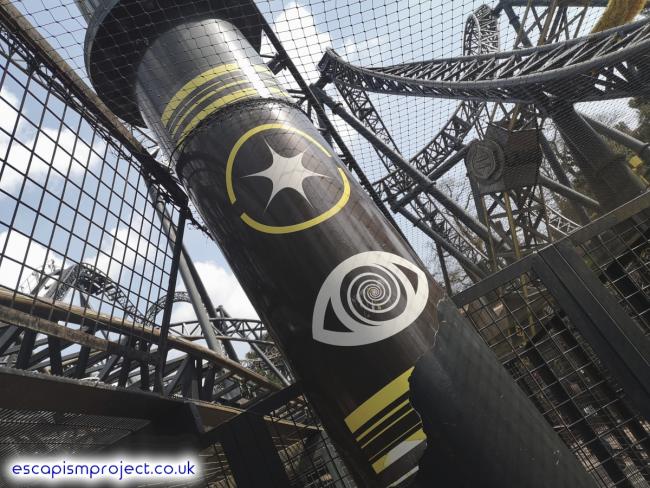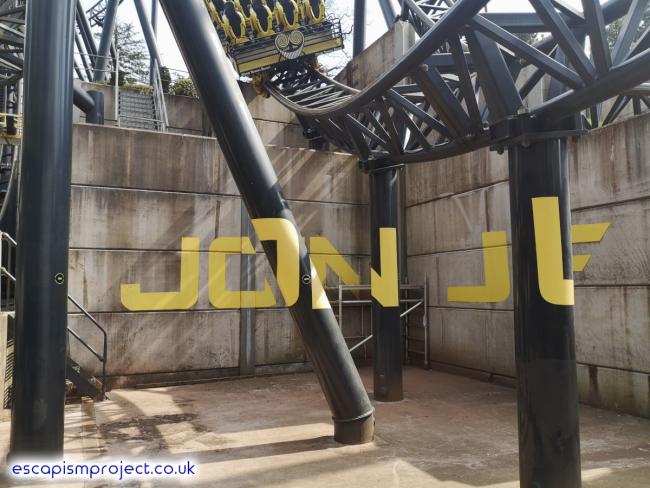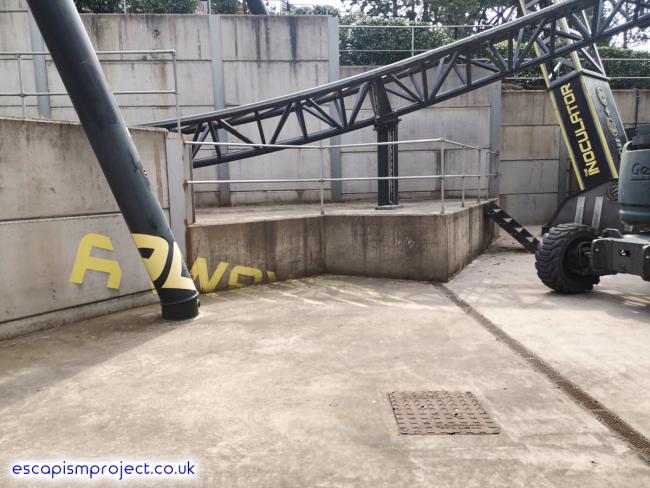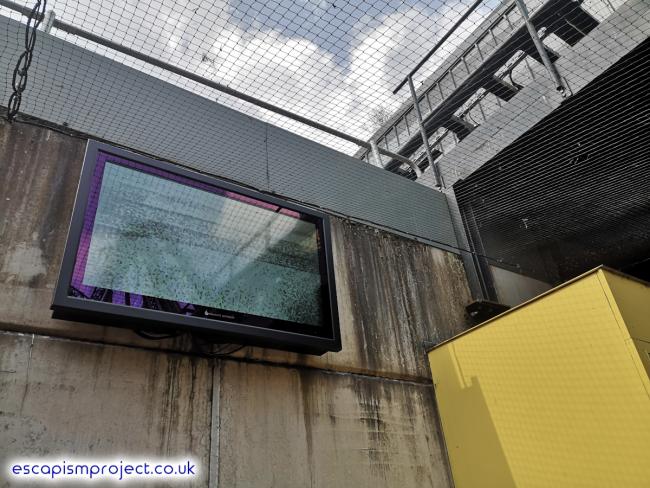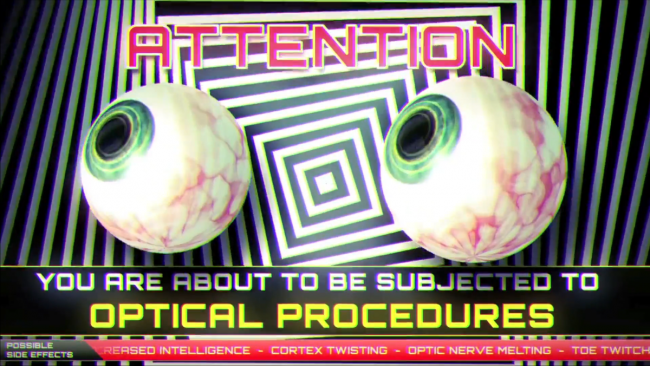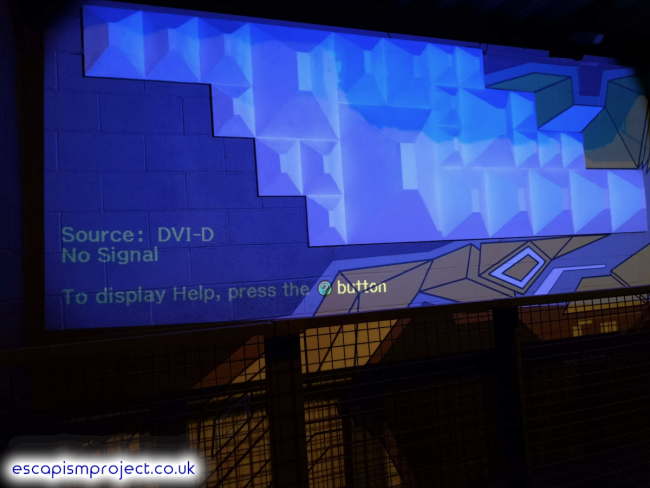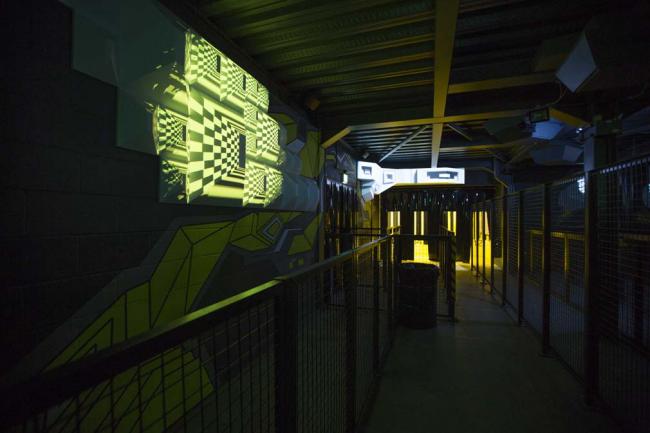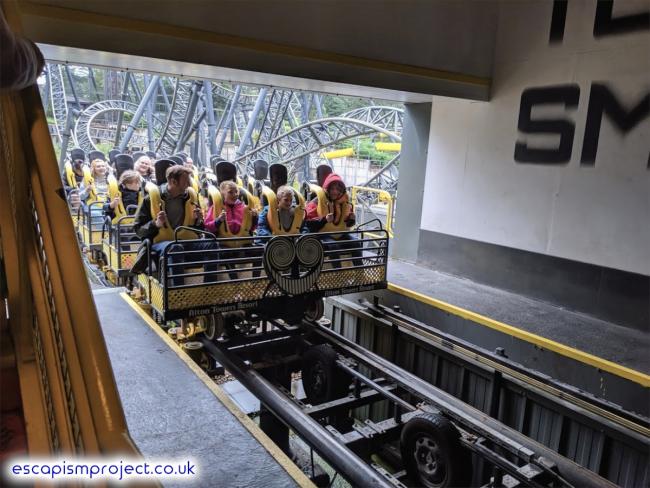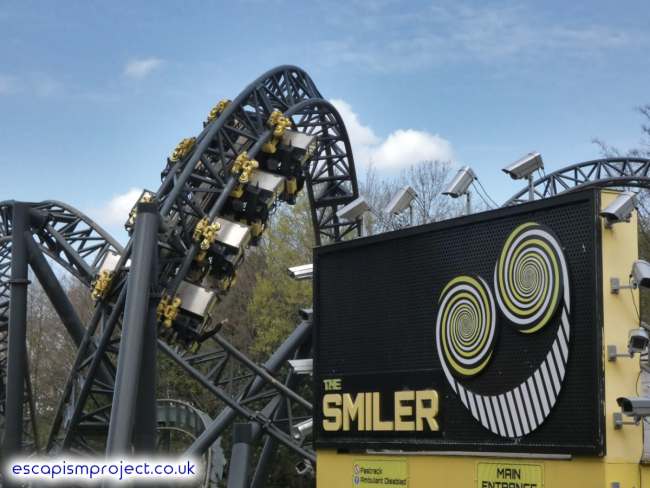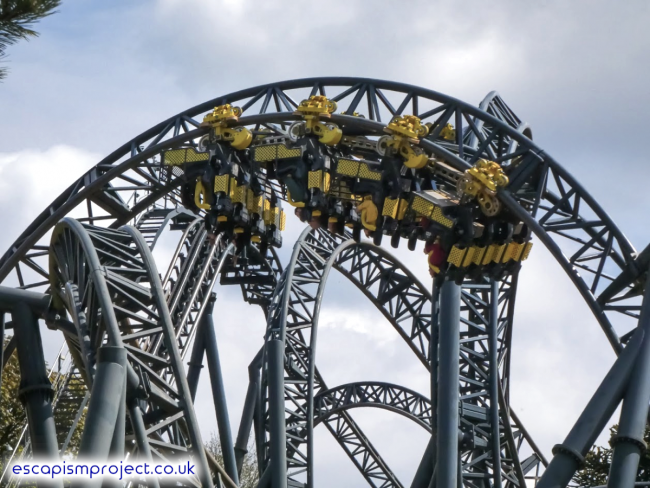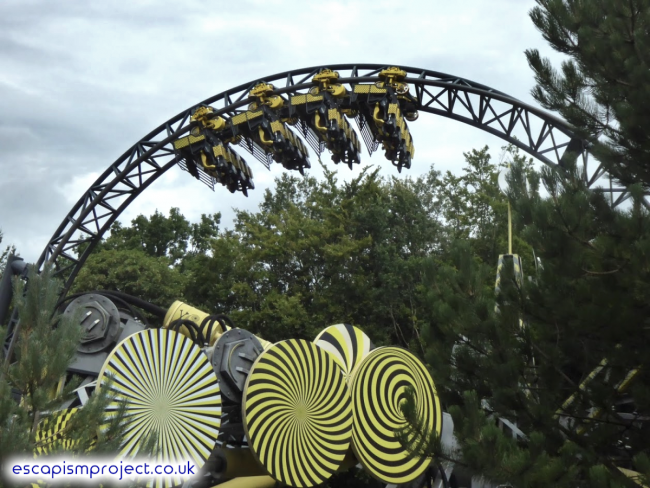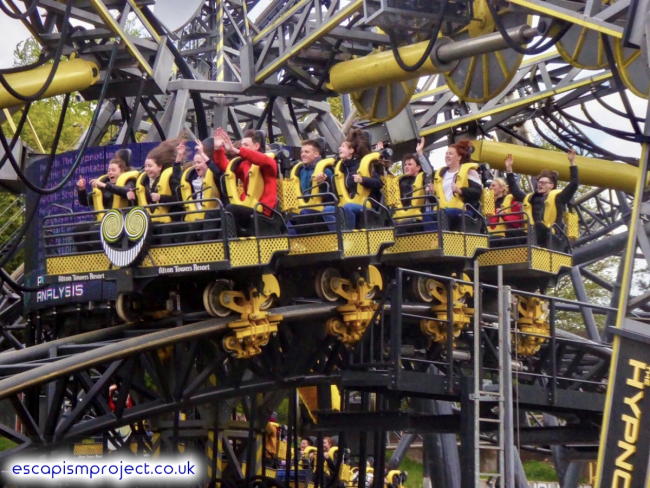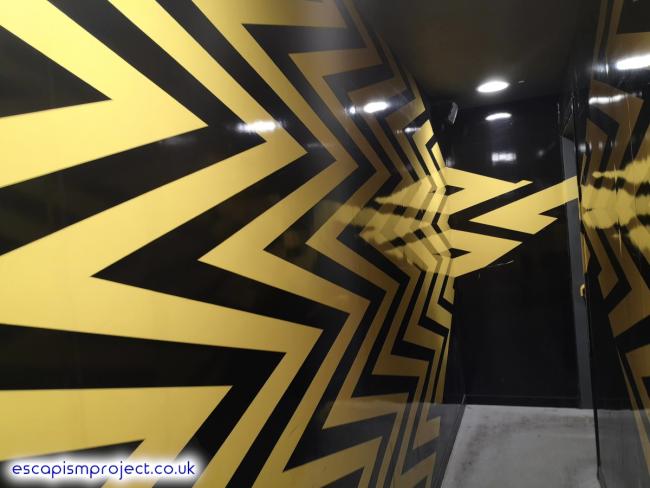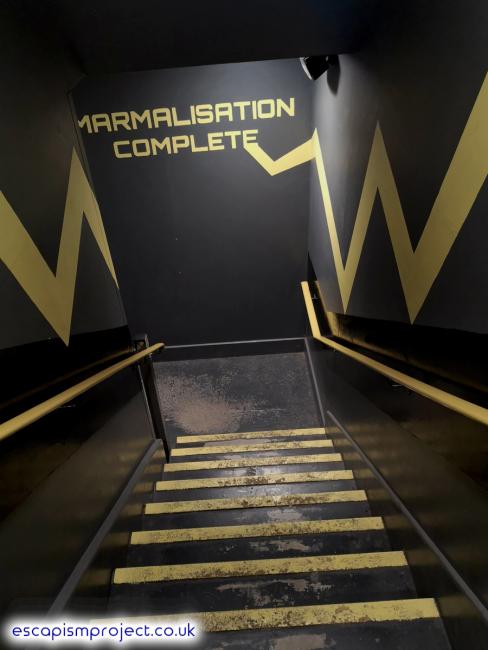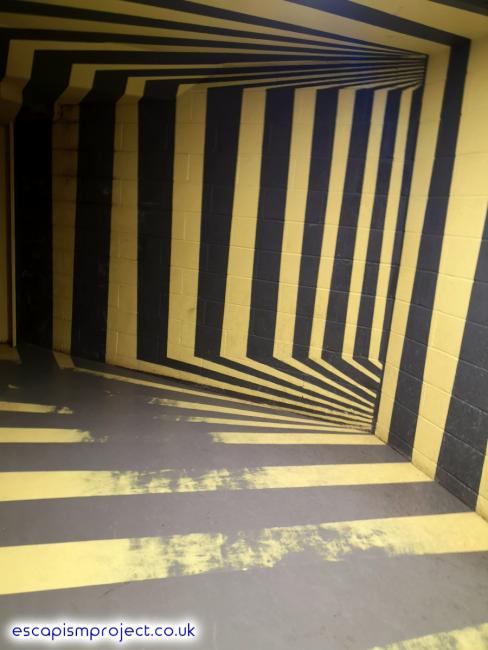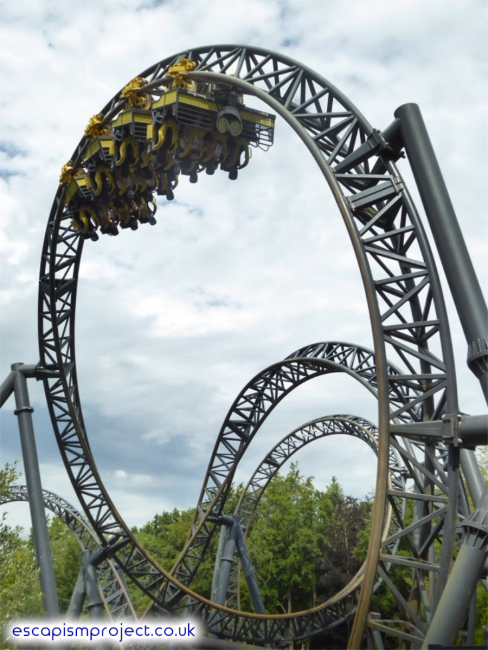
Content Description: Existentialism, Politics, Horror, Sex References, Ableist Language, Mental Illness Theme
There is a clear definition between theme parks and amusement parks. Whilst both share the same core goal - an energetic escape from the frenetic metropolis' we all live in - they achieve this in different ways. Huge, imposing steel structures dominate visions of both, but an amusement park uses this as the sole focal point. Parks such as Blackpool Pleasure Beach and Gröna Lund primarily use rollercoaster hardware to thrill via the forces nature delivers, with a smattering of light decoration to distinguish one ride from the next. Whereas a theme park, places like Efteling and Phantasialand, use these enormous transit systems simply as a way of traversing a narrative. Such structures are often dwarfed by colossal castles and lushious landscaping - storytelling is well and truly the paragon of these places.
This style of immersive storytelling is an art form in itself, and several simple tricks are used to create complex experiences that are so well refined that guests can lose themselves in the fantasy presented. Ensuring the theme is relevant to the style of ride is perhaps the most important thing - there's not much point taking a boat ride intended for children and dressing it with petrifying props, as this would alienate audiences. Those who would enjoy the gentle nature of the stream would be put off by the ghouls; guests of an older age would find the opposite. And it's not as simple as just plonking an adult theme on adult hardware - it is important to consider what audiences would wish to receive from an experience. There is little point lecturing bored teenagers on the threats of fracking if all they're wanting is to feel their blood rush to their heads. You've also got to figure out how you entice guests to your attraction - clever path placement, sightlining, and subsequent rides all impact the experience, often in a way which you don't notice - but you can sometimes tell when these haven't been taken into account.
A tremendous amount of research has to take place before designers and engineers can figure out what exactly they're going to build, in hopes they can create an attraction that is suitable for its market, doesn't impede on other rides' victories, and can entertain generations for decades afterwards.
One of the best examples of these philosophies being utilised in a thrill ride is in the United Kingdom. Upon approaching the Forbidden Valley area of Alton Towers, a gradual decline, surrounded by monolithic rocks, directs guests towards a tall, rusty archway, topped with a sign that demands attention: "Nemesis". Beyond this feature, a slither of grey track can barely be seen, and a rough rumbling can be heard from afar. The mystery of the slope, the rockwork, the noise, pulls guests towards an awe inspiring vista; both above and below, steel rollercoaster track can be seen snaking around a ravine, with trains full of petrified passengers zooming around at intense speeds. Upon turning left into the queue, guests are led deeper into the pit, and as they revolve around the ride, another portion of the layout is revealed; a large loop looming high above them. Another act of daring drama is added, with a sheer drop on one side, and a skeletal, grotesque alien creature on the other. All this fun before you've even climbed aboard the dangling trains. But, for those too intimidated to ride, they can still enjoy the experience by exploring a multitude of pathways that weave around the track, to provide fun and invigorating views as the coaster interacts with the rubble. Also, an eerie score, composed by industry veteran, Graham Smart, plucks our heartstrings in a multitude of ways; some solemn notes provide a sombre sensation, whilst loud horns often burst onto the scene to remind us of an unknown danger lurking within the pit.
Nemesis is a masterpiece of theme park design with some sumptuous sightlining, incredible interactions with the area, and a suitable air of mystery. The creatives of Tussauds Studios understood the fundamentals of what makes an attraction good, and used all available ingredients to create one of the most delicious delicacies available at the time. What is perhaps more astounding is the way the attraction tells its story in a beautifully subtle way - it doesn't intrude on the pure thrill experience. A remarkable achievement on behalf of the designers, especially considering that, after almost three decades, its efforts remain unbeaten in this country.
On the other side of Alton Towers, a ride just as - if not more so - famous and beloved as Nemesis, is The Smiler, a behemoth bolstering a record breaking fourteen inversions, packed into a crazily compact coaster experience. Themed to an ominous Orwellian organisation, known as the Ministry of Joy, this kooky 'correctional device' aims to send riders into a unique europhia, evoking hypnotic happiness and hysteria, capable of deriddling minds of emotional depravity and depression. Since opening in 2013, the ride has captivated a curious collection of cultists, each craving this curious creation more than seemingly possible. It'd be safe to assume, then, that The Smiler builds on the successes of it's inverted cousin, with superbly streamlined sightlining, concise, smart lore, and intriguing interactions with the surrounding X Sector. Sadly, it isn't quite as simple as that. Whilst the attraction certainly has some interesting ideas and creative concepts, the thematisation and presentation is far from amicable.
From the outset, The Smiler seems to boast one of the most unusual themes to have ever appeared on a ride. Instead of opting for something standard, such as the seemingly infinite amounts of superhero, movie or pirate overlays, Alton Towers took the liberties of creating something more exclusive for their headliner. Guests - or 'Advocates' - as the marketing exclaims - are invited to partake in a five stage treatment, including inoculations and hypnosis, to banish sadness to the realms of the unimaginable. You'd be hard pressed to find another coaster with such a bold identity; garish yellows and blacks set against metallic mazes make up the majority of visuals associated with the coaster. It's certainly an edgy appearance with an idea that seems like a commentary on society and choice, but it ends up contradicting this, by stigmatising and mocking the mentally ill.
An interesting comparison can be drawn with Anthony Burgess' notorious novel, and visionary director Stanley Kubrick's 1971 movie adaptation, A Clockwork Orange. Alex, a teenage delinquent and his brash band of 'droogs' run rampant in the evenings, partaking in extreme acts of violence and sexual activity, gaining some sort of sick satisfaction from the suffering inflicted upon others. Instead of spending 137mins glorifying all sorts of assaults, the majority of the story is spent on the effects of the 'Ludovico Treatment', wherein patients are brainwashed into abstaining against sex and violence, by physically stopping them from being able to commit acts of either. This raises the fantastical philosophical question: Alex, if left to his own devices, will continue to pillage for fun, and the only way to stop him is by retracting his free will. But, the ethics of this are uncertain. Choice and freedom is a basic human right, but the only way of 'curing' people in this scenario is by removing that freedom. Alex should be able to choose to comply with society, rather than actively going against it. As the Chaplain says in the movie, "goodness comes from within".
A Clockwork Orange, Warner Bros., 1971
A Clockwork Orange shares a similar parallel with The Smiler - albeit in a much more adult and astute way. Sadly, depression - a requiem for ecstasy and an overpowering gloom that looms over every moment - is a very real illness. Every little luxury that usually evokes elation barely brings even the smallest smile to those suffering. It's an immensely devastating condition to live with, and trying to break the chain bound by the immeasurable amounts of sadness can be challenging. The Smiler aims to 'cure' the upset by removing advocates of their own characteristics and transform them into a smiling goon - a mere shallow shell of a human, a husk, incapable of choosing cheerful activities to try and brighten their days. Deleting depression is certainly an illustrious idea; but straight up emotional eviction devalues the human experience. Without the opposition of happiness, you can never really truly appreciate the satisfaction of smiling.
It's certainly a creative concept to tell this story about morality and the quandary of free will - something which A Clockwork Orange, despite its age, relishes in. Sadly, The Smiler fails to capture the same essence, and falls flat with its depiction of depression versus happiness. Whilst the ride does have a tremendous amount of lore, including spin-off scare maze, The Sanctuary (which shares its theme tune, Mantovani's Charmaine, with another film about mental illness, One Flew Over the Cuckoo's Nest), there is little to no evidence of this within the ride experience. The story is reduced to nothing more than a mere series of feebly forced corporate catchphrases on monitors dotted around the ride. These statements, including 'Join Us' and 'Get Corrected' (the latter has since been removed due to external factors) don't offer any existentialism within their nature. They're just telling guests how they should feel, rather than inviting them to ponder about morality in a mature and dignified manner. Subtlety in a theme can be done well, as Nemesis proved back in 1994 - the narrative is never explicitly explained - but it feels much more potent and damaging for The Smiler, which feels like an attempt at a story based ride.
Perhaps this is due to the hardware itself. Most guests ride The Smiler because they want to endure the forceful fourteen inversions, and maybe Alton Towers recognised this, and as such, didn't put as much thought into the theme, which is a shame, as it's a novel notion essentially wasted. But the question is this: would this story have worked in a dark ride, or, another scare maze? The answer: we'll never know. We'll never know how these ideas would be handled with the right amount of attention and fragility.
Unfortunately, the way the theme is handled also stigmatises and invalidates many peoples struggles. Without it being apparent that the ride is about the contradiction of society, the experience feels like a mockery and a perplexing pastiche of illness. Defeating depression isn't as easy as '[Opening] your Heart to Joy', as the ride shouts at you. A fine balance of healthy lifestyle changes and the right amount of medication is how many depressed people find a way out of the abyss, rather than straight up hypnotism. Depressed people aren't choosing to be depressed - they can't just snap out of it and smile, and it feels like that's what The Smiler is telling you to do. The ride echoes the infamous inhumane treatments of 1950s institutions - an intentional choice - but it brushes off in the wrong way, and touches many a nerve.
The use of catchphrases comes across as incredibly corporate, and the theme as a whole, is somewhat ableist, by disregarding genuine struggles. Perhaps coincidental, but it is curious that those who are subjected to The Smiler's treatments, and those who ally themselves with the ill, are known as 'advocates'. Whilst both the Ministry of Joy and mental health advocates wish to assist and alleviate their peers' pains, the methods used by both could not be further apart from each other. And whilst this is nothing more than a façade to front a rollercoaster, some take it too far.
Upon its original opening, amongst the merchandise being sold were sweets branded as 'happy pills' - which disgustingly invalidates those on antidepressants. Starting a course of medication can be very daunting, especially considering the taboo nature associated with tablets, or 'mind control drugs' as some immature individuals deem them. Society shouldn't be stigmatising medication, as when taken sensibly, they can help with a plethora of both physical and mental conditions. By selling 'happy pills' as merchandise, they're essentially mocking the sick to sell a quick gag at their expense. People are often already super self-conscious about having to take pills, but this was certainly a step too far. Thankfully these are no longer sold.
Sloping down into the scientific sounding X Sector, the scared screeching screams of riders greets guests heading the area, and immediately, The Smiler unceremoniously stands tall amongst stainless steel barricades and wired fencing. It's somewhat of a mechanical marvel; an engineering enigma; a fearful feat to behold. Weaving seemingly infinite amounts of track in and out of itself in a meagre footprint is quite a spectacle. For those unfamiliar with the layout, trying to follow the versatile vehicles is somewhat impossible, and it can be really enjoyable to watch for those who don't think they can stomach the fourteen inversions - but the sightlining leaves a lot to be desired.
Whereas the aforementioned Nemesis slowly reveals it's alien appearance and invites the audience to explore every nook and cranny of the perilous pit, Smiler fits rather neatly into a self-confined box - a cardinal sin in itself.
Imagine, if you will, that you have a large plot of land, more or less in the shape of a square, and you've been challenged to fill this square with the most exciting rollercoaster imaginable, capable of entertaining as many people as possible. You could separate the plot into two areas - a small, rectangular viewing plaza for guests, with the majority of the remaining land designated for the coaster. Whilst you'd likely end up with a longer and more exciting ride in the physical sense, there is no pathway that interacts with the coaster, meaning for those unable to ride it, they're restricted to viewing it from a predetermined angle along the side of the area. Or, you could try and weave a myriad of pathways through the box, and have a slightly shorter coaster run perpendicular to them, so that families can gain enjoyment from the ride and view it from an infinite amount of theatrical angles, without having to join the queue.
A well designed ride, such as Nemesis, or Phantasialand's Taron, are ingeniously integrated with their surrounding areas by allowing guests to freely flow around the track, so that those too frightened to endure the forces provided can still feel involved with the ride.
Smiler opts for the first option - take the box and fill it with nothing but coaster, offering a limited view for those non-riders. Whilst the main paths of the area do contour around the footprint of the ride, the queue leads guests underneath the ride, and is less offensive than the boxy nature of their subsequent thrill coaster, Wicker Man, it feels unnatural and awkward. And when entering X Sector, guests are led down a narrow path with the ride on their right, meaning that if you're wanting to bask in awe at its superb scale, you've got to awkwardly crane your head in one direction whilst trying to avoid all the traffic provided by the bottleneck. Trying to view the ride without riding it means pushing forward and trying to find somewhere that isn't overcrowded to view it from - and by segregating riders and non-riders by having no public pathways through the ride itself, this really affects enjoyment. The lack of a natural sightline really hurts an initial impression, and in fact, steals the spotlight from another ride with well designed drama and substance - Oblivion.
When Oblivion opened in 1998, the new X Sector was designed specifically with this in mind. Upon entering the area, the first thing guests would see was a vision of the valiant vertical drop vacuuming participants towards it, each step adding another foot onto the sheer height of this tall terror. Eventually, the perilous plunge could be seen in all its glory, piercing the ground as it fearfully fell into the void below. Guests were encouraged to get as close to the pit as possible, and the frequency of cars meant that many guests could happily sit and watch whilst their families braved the drop.
By placing The Smiler immediately on the entrance path of X Sector, all attention is drawn to it instead, and observation of Oblivion is stolen - which is a shame, as it succeeds where The Smiler fails. The Smiler feels poorly integrated into the area - instead of moving paths around to try and create a superior, theatrical introduction, it's more or less perfectly confined to the footprint of its predecessor, the Black Hole. Trying to squeeze a spectacular specimen into a pre-existing, compact plot, was certainly a challenge, and credit is due for managing to achieve it; but the trade-offs don’t feel worth it. It lacks a certain jocularity and interactive charm that makes Nemesis and Oblivion so magical and memorable to so many. It's interesting that, one of the most favoured views of the ride is only available from the entrance to the Men's bathroom because they were insistent on keeping the toilet block there - in fact, part of the roof had to be chipped off to allow for the supports to be placed.
For those willing to feel their head spin with a fleeting flurry of fourteen ferocious flips, there's only one thing for it - riding The Smiler - after hours of enduring the exhausting, endless queue.
Ask anyone what their memories of The Smiler's queue are, and they'll almost certainly mention the infamously inextricable soundtrack that blasts out at a somewhat nauseating volume. This obnoxious suite comprises of two very simple, dull melodies - if you could even call them melodies - that repeat seemingly forever. To make matters worse, the instrumentation is primarily made up of lackadaisical laughter that is beyond irritating - even if there is no queue. It's certainly hypnotising, but it does the exact opposite of its task. Having to spend 30 minutes, or is more often than not the case, hours, listening to this unimaginitve piece of music - is somewhat tortuous. Before writing this essay, I decided to give the soundtrack a chance to redeem itself by listening to the entire 75 minute long score in one sitting, as if I had to wait a long time for the ride; by the end, my mood had dropped significantly, and had developed such a short fuse that it majorly affected my productivity that particular evening. If you thought It's a Small World has an annoying score - languish this humble thought before riding Smiler.
Descending into the pit, and it becomes apparent what the rest of the queue has in store. The entirety is built up of claustrophobic cages, with a route that snakes back on itself so many times that there's no sensation of progress every time the line moves. Some rides use long waits to their advantage, and provide a plethora of awesome angles of the ride, serving as a tantalising taste of what's to come. The Smiler sits entirely above you - something which is kind of cool for the first few minutes - but before long, it becomes a massively monotonous slog, being herded like cattle with no view as to when this hell would end. Like the soundtrack, even when there is no queue, having to walk through this massive metallic maze brings down the excitement of riding something that seems so seraphic. Unceremoniously shuffling along every few minutes is a necessary evil for all rides, but here, it's not fun in the slightest.
But what is immediately evident is how grotesque the setting of the ride is. As Alton Towers are unable to build above the treeline, the majority of their coasters are sunk into the ground. Rides like Nemesis and Oblivion use this tremendously with huge ravines carved out for them; Smiler is rather lazily dunked in a squalid concrete chasm. Brutalist architecture vaguely fits in with the lore of 1950s institutions, and has always been a contentious topic; the majority loathe it, whilst some adore it. Every direction is dominated by flat, cold, coarse concrete; their only characteristics being copious amounts of rot and decay. Every surface - not just the pit, but the track, supports, theming features - are caked in rust and dirt, which gives the impression that the ride has remained untouched for decades; hastily abandoned and left to fend for itself. And when it rains - as is commonplace in Britain - the queue starts to flood because of a botched drainage system. Being trapped in the queue and having to wade through waves of water is frustrating, especially when considering a staggering £18 million was spent on the ride, and that it can't even get rid of excess water correctly. What is worrying is the ride is yet to even celebrate ten years of service, and yet already, is as charming as a council car park.
Whilst a gigantic, arachnid inspired 'Marmaliser' serves as the centrepiece, the majority of the 'theming' is just lazy, faded marketing phrases spray painted onto the walls of the pit. A scarce screen tries to imprint the backstory in our minds by blandly repeating the same collection of catchphrases on loop. It's no secret that most people favour physical set pieces as opposed to cheap screens displaying graphics; you're primarily at a theme park to see the real thing. One particular screen that links to an earlier point about stigmatising antidepressants showcases a number of 'side effects' that riding The Smiler can bring. It's a fun little gag, but once again, comes at someone else's expense. Many types of medication come with a set of side effects - whilst most wash away within a few weeks of starting treatments, they can be terribly disruptive - and some anti-depressants, in fact - depress patients further before they start to work.
The Smiler Queue, Bottletop, 2013
It's not exactly a romantic recipe; highly maddening music, unimaginative fencing, bland theming, all set within a dank, dirty trench - it's hardly happy at all. Some people claim that the grimy, repetitive accents give the ride character, and intentionally put you into a depressive state so that the ride can cheer you up, and that this is masterful design - which is somewhat doubtful. There genuinely is nothing redeemable or fun about being sent spiralling towards a low because you're queueing for a rollercoaster - something which you're doing to provide unequivocal thrills. As anyone with depression will tell you, the only good thing about being depressed is not being depressed at all.
Towards the final mind-numbing minutes of this purgatory, guests enter the 'Correction Block', a small, dark room, laced with projections of intriguing illusions, with the idea of 'disrupting your self awareness'. Again, a cool concept - albeit a stigmatising one. The execution here, however, is somewhat hindered by the reliability of the effects. You'd be hard pressed to experience The Smiler on a day when all the projectors were working, let alone correctly aligned with the walls, as they're mounted on a ceiling where a rumbling ride takes place directly above.
Seeper, 2013
Ascending to the station, it's finally time to ride this king of coasters. Boarding the Infinity trains in a dusty white room - which too is plagued by grit - another catchphrase is spouted out as the coaster finally begins - which is as polarising as the theme and presentation. Gerstlauer's coasters aren't exactly renowned for their smoothness, and it's no different here. The entirety of the ride has this rocky, rumbling sensation, with the all too frequent jolts jostling agonised advocates around the bulky yellow restraints - which mercilessly claw into their shoulders, waistlines, thighs, and for those of some stature, feet. Traversing so many tight inversions in such a short time frame will almost certainly leave riders with a splitting headache that'll last for some hours afterwards. And it's somewhat ironic that, in a ride all about turning you upside down, most peoples favourite moments are the two airtime hills - although some people prefer the final brake run.
Arriving back into the station, bruised and battered by the ride's rough rampage, guests have been 'marmalised', and are now happy forevermore - perhaps because they can collect their bags and exit through another series of broken optical illusions - but not after the mandatory merchandising outlet. With over 80 products when the ride launched, and an onslaught of new pieces being made available every season, Buy The Smiler is a fever dream of a shop. One tasty touch is in the form of The Smiler Shop TV, where a pair of presenters showcase (mostly discontinued) lines of merchandise, mocking consumerism and infomercials in the process. It's a really fun idea - but again, spoilt by how it is presented. The Smiler is incredibly corporate with it's seemingly endless arrays of shirts, jumpers, hats, wristbands, models, toys, paperweights, stationery, bed sheets - the list goes on ad infinitum. Essentially it's a parody of itself - maybe this self awareness is intentional, but it just doesn't feel quite right, as their motive is more about money rather than humour. One does wonder what the entirety of the ride could've been like with this tongue-in-cheek style rather than the pseudo-serious take the designers went for.
The Smiler Shop TV, Bottletop, 2013
Unfortunately, it's impossible to talk about The Smiler without acknowledging some of the issues the ride has had, including numerous faults during construction, testing, and operation; but it's popularity remains undiminished, despite its history of dividing public opinion.
It's oddly fascinating that a ride that is so stigmatising in theme, broken and disjointed as an experience, and one that has been surrounded by so much controversy over its relatively short life span, has such a large following. An ever increasing number of fans find themselves with The Smiler inspired wardrobes and costumes to wear in and outside Alton Towers, almost like an ode to the creepy commercialism of the ride. It's a curious obsession, especially how some people become so dangerously involved with the ride, that some would take a criticism of the ride as a personal attack and critique of themselves, as if The Smiler is their defining trait and a personality. Weirder still, certain parts of the community have taken to fetishising the ride and its lore.
As an outsider, it's intriguing to observe. One such comparison can be found with hype culture - things like the Star Wars and Harry Potter franchises - where fans become so engrossed with their favourite pieces of media that it becomes toxic and harmful to the perception of the piece. Much like horror game series, Five Nights at Freddy's - which hit its peak of popularity shortly after The Smiler opened - adopting it as ones own could be a desire to stand out and make an edgy statement. Much like how A Clockwork Orange is primarily famous for its obscene amount of vulgar violent and sexual content.
The lore of The Smiler and the Ministry of Joy remains somewhat unexplored within the ride experience, but it's primarily the idea itself that keeps punters coming back for more. Old promotional material feeds a dark curiosity as to what exactly went into the ride. It's the same reason many horror stories leave things unexplained; it's basic psychology to fear the unknown. The shoddy, B-Movie miniseries, Smile. Always., provides a nostalgic buzz for many younger fans with its lacklustre production values, yet it carries an awkward charm about it, as many early viral videos often do. Perhaps the lack of narrative on the actual ride acts as a strength for some, as many people find additional value by researching the lore later on. This backstory - albeit basic and hidden away for only the most die-hard fans - has kept the legacy of The Sanctuary alive and kicking.
Although I don't quite understand its appeal - kudos to those who enjoy the ride, despite its flaws. More power to you for being able to enjoy it!
It's been eight years since The Smiler first thrilled passengers with its stigmatising theme, questionable execution, and cranium crushing roughness - whether you like it or not, it's clear it will be here to stay for many years to come, and is well and truly a favourite amongst fans, with many enthusiasts travelling to England purely to ride it. And it's appeal is somewhat clear - who wouldn't like the loopiest coaster on Earth? Perhaps because of the points raised, not everyone enjoys this controversial coaster.

